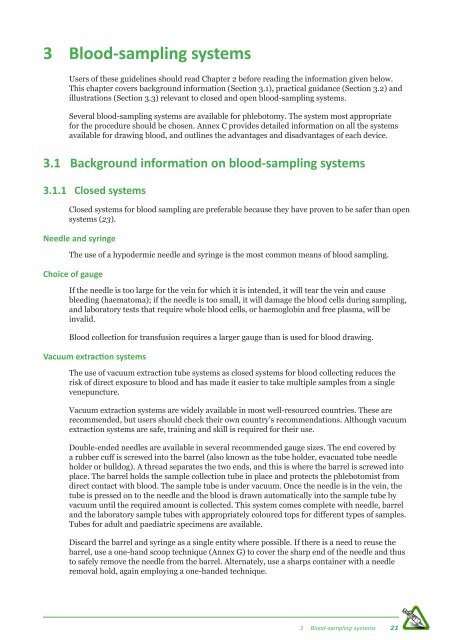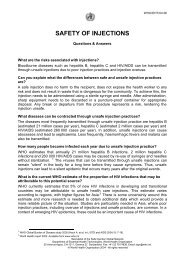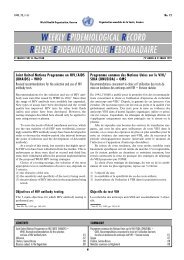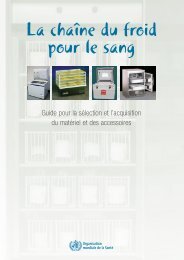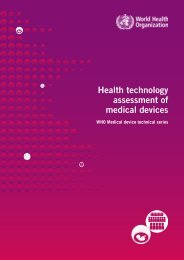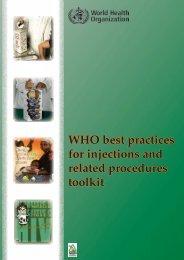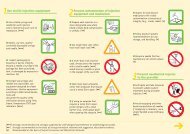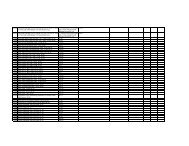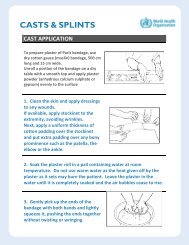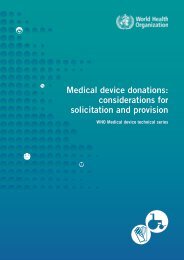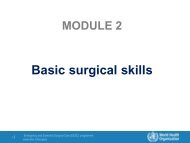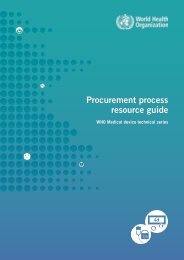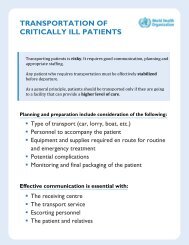WHO Guidelines on Drawing Blood: Best Practices in Phlebotomy
WHO Guidelines on Drawing Blood: Best Practices in Phlebotomy
WHO Guidelines on Drawing Blood: Best Practices in Phlebotomy
- No tags were found...
Create successful ePaper yourself
Turn your PDF publications into a flip-book with our unique Google optimized e-Paper software.
3 <strong>Blood</strong>-sampl<strong>in</strong>g systems<br />
Users of these guidel<strong>in</strong>es should read Chapter 2 before read<strong>in</strong>g the <strong>in</strong>formati<strong>on</strong> given below.<br />
This chapter covers background <strong>in</strong>formati<strong>on</strong> (Secti<strong>on</strong> 3.1), practical guidance (Secti<strong>on</strong> 3.2) and<br />
illustrati<strong>on</strong>s (Secti<strong>on</strong> 3.3) relevant to closed and open blood-sampl<strong>in</strong>g systems.<br />
Several blood-sampl<strong>in</strong>g systems are available for phlebotomy. The system most appropriate<br />
for the procedure should be chosen. Annex C provides detailed <strong>in</strong>formati<strong>on</strong> <strong>on</strong> all the systems<br />
available for draw<strong>in</strong>g blood, and outl<strong>in</strong>es the advantages and disadvantages of each device.<br />
3.1 Background <strong>in</strong>formati<strong>on</strong> <strong>on</strong> blood-sampl<strong>in</strong>g systems<br />
3.1.1 Closed systems<br />
Closed systems for blood sampl<strong>in</strong>g are preferable because they have proven to be safer than open<br />
systems (23).<br />
Needle and syr<strong>in</strong>ge<br />
The use of a hypodermic needle and syr<strong>in</strong>ge is the most comm<strong>on</strong> means of blood sampl<strong>in</strong>g.<br />
Choice of gauge<br />
If the needle is too large for the ve<strong>in</strong> for which it is <strong>in</strong>tended, it will tear the ve<strong>in</strong> and cause<br />
bleed<strong>in</strong>g (haematoma); if the needle is too small, it will damage the blood cells dur<strong>in</strong>g sampl<strong>in</strong>g,<br />
and laboratory tests that require whole blood cells, or haemoglob<strong>in</strong> and free plasma, will be<br />
<strong>in</strong>valid.<br />
<strong>Blood</strong> collecti<strong>on</strong> for transfusi<strong>on</strong> requires a larger gauge than is used for blood draw<strong>in</strong>g.<br />
Vacuum extracti<strong>on</strong> systems<br />
The use of vacuum extracti<strong>on</strong> tube systems as closed systems for blood collect<strong>in</strong>g reduces the<br />
risk of direct exposure to blood and has made it easier to take multiple samples from a s<strong>in</strong>gle<br />
venepuncture.<br />
Vacuum extracti<strong>on</strong> systems are widely available <strong>in</strong> most well-resourced countries. These are<br />
recommended, but users should check their own country’s recommendati<strong>on</strong>s. Although vacuum<br />
extracti<strong>on</strong> systems are safe, tra<strong>in</strong><strong>in</strong>g and skill is required for their use.<br />
Double-ended needles are available <strong>in</strong> several recommended gauge sizes. The end covered by<br />
a rubber cuff is screwed <strong>in</strong>to the barrel (also known as the tube holder, evacuated tube needle<br />
holder or bulldog). A thread separates the two ends, and this is where the barrel is screwed <strong>in</strong>to<br />
place. The barrel holds the sample collecti<strong>on</strong> tube <strong>in</strong> place and protects the phlebotomist from<br />
direct c<strong>on</strong>tact with blood. The sample tube is under vacuum. Once the needle is <strong>in</strong> the ve<strong>in</strong>, the<br />
tube is pressed <strong>on</strong> to the needle and the blood is drawn automatically <strong>in</strong>to the sample tube by<br />
vacuum until the required amount is collected. This system comes complete with needle, barrel<br />
and the laboratory sample tubes with appropriately coloured tops for different types of samples.<br />
Tubes for adult and paediatric specimens are available.<br />
Discard the barrel and syr<strong>in</strong>ge as a s<strong>in</strong>gle entity where possible. If there is a need to reuse the<br />
barrel, use a <strong>on</strong>e-hand scoop technique (Annex G) to cover the sharp end of the needle and thus<br />
to safely remove the needle from the barrel. Alternately, use a sharps c<strong>on</strong>ta<strong>in</strong>er with a needle<br />
removal hold, aga<strong>in</strong> employ<strong>in</strong>g a <strong>on</strong>e-handed technique.<br />
3 <strong>Blood</strong>-sampl<strong>in</strong>g systems 21


